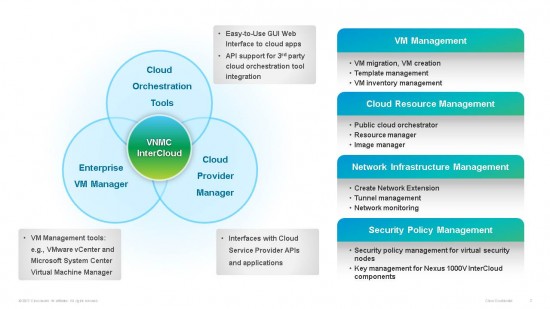This week, as part of a major cloud launch that also introduced the Nexus 6000 series and updates to our Cisco ONE portfolio, Cisco unveiled its Nexus 1000V InterCloud solution, which provides a seamless and secure extension of virtual networks from on-premises data centers to cloud service providers. In part 1 of our introductory blog series to this new technology, we discussed the architecture and components of Nexus 1000V InterCloud for creating secure, on-demand virtual private cloud (VPC) containers in a hybrid cloud. In a pre-launch post earlier in January, we looked at some new Forrester research data on hybrid cloud business drivers and how some organizations were looking to overcome the challenges to real hybrid cloud integration. Today, in part 2 of our InterCloud series, we are going into more depth about the hybrid cloud management component, Virtual Network Management Center (VNMC) InterCloud.

VNMC InterCloud plays an important role in managing and enabling a hybrid cloud by providing a single management console and a single view for resources in both the enterprise and cloud infrastructures. This makes it easy to manage and provision virtual networks and virtual services that span the data center and service provider sites. But the real beauty in the VNMC management layer is the ability to move workloads within the hybrid cloud (i.e., across private and public clouds), potentially as easy as migrating them between racks in a data center.
To put this into perspective, imagine being able to deploy apps beyond your internal, enterprise private cloud, when you suddenly need additional capacity. In some cases, additional capacity need may be transient, for which you don’t want to build permanent infrastructure. In other cases, you may want to build the infrastructure but procuring and deploying equipment from multiple vendors may take a few weeks.
Instead, with Cisco Nexus 1000V InterCloud, you can summon cloud provider servers at peak times and migrate workloads between your data center and the cloud service provider via secure multi-tenant connectivity. This enables users to relocate their workloads without the need to reconfigure their applications and by maintaining existing network assignments. Because consistent management is mandatory for a cohesive user experience, VNMC provides a single, transparent pane for management of both private and cloud provider environments. Enterprises even have the ability to select multiple cloud providers to weave together into an optimal hybrid cloud infrastructure.
In addition, VNMC plays an important role in Cisco virtual services (e.g. virtual firewall) deployments by implementing a policy-based model that can scale for dense multi-tenant environments. This is crucial for customers who wish to scale their virtual network services across private and public environments, helping users avoid repetitive network provisioning across the many service nodes. VNMC Intercloud also simplifies virtual firewall deployments since it already manages Cisco Virtual Security Gateway (VSG) and ASA 1000 Cloud Firewall policies within the data center, which can now be managed consistently across the hybrid cloud.
As the above diagram shows, one of the key integration points for VNMC InterCloud is to enterprise VM management tools for managing virtual machines and policies. Today VNMC InterCloud interfaces to VMware’s vCenter (see demo here), and in the future to Microsoft’s System Center Virtual Machine Manager (SCVMM).

Another key feature of VNMC InterCloud is its northbound API interface, which expands VNMC’s management capabilities beyond its core network management functions to cloud orchestration systems, such as Cisco Intelligent Automation for Cloud (Cisco IAC; see above diagram), Cisco Cloupia, as well as 3rd party orchestration tools. Cisco IAC features an end-user self-service portal (Cisco Cloud Portal) and an IT process automation engine (Cisco Process Orchestrator) to drive provisioning workflows. By using VNMC’s northbound interface, you can incorporate these features into the InterCloud architecture to further expand your network infrastructure automation.
Next up, later this week, in the concluding part 3 of our introductory series on Nexus 1000V InterCloud, we’ll answer a number of the basic questions we’ve been getting on InterCloud, and some of the details that may have been overlooked in the initial announcement.
For more information on VNMC InterCloud, check out the new Nexus 1000V InterCloud web page, and the rest of Cisco’s Unified Management portfolio. For direct questions regarding the VNMC InterCloud, e-mail your questions to: intelligentautomation@cisco.com.
CONNECT WITH US